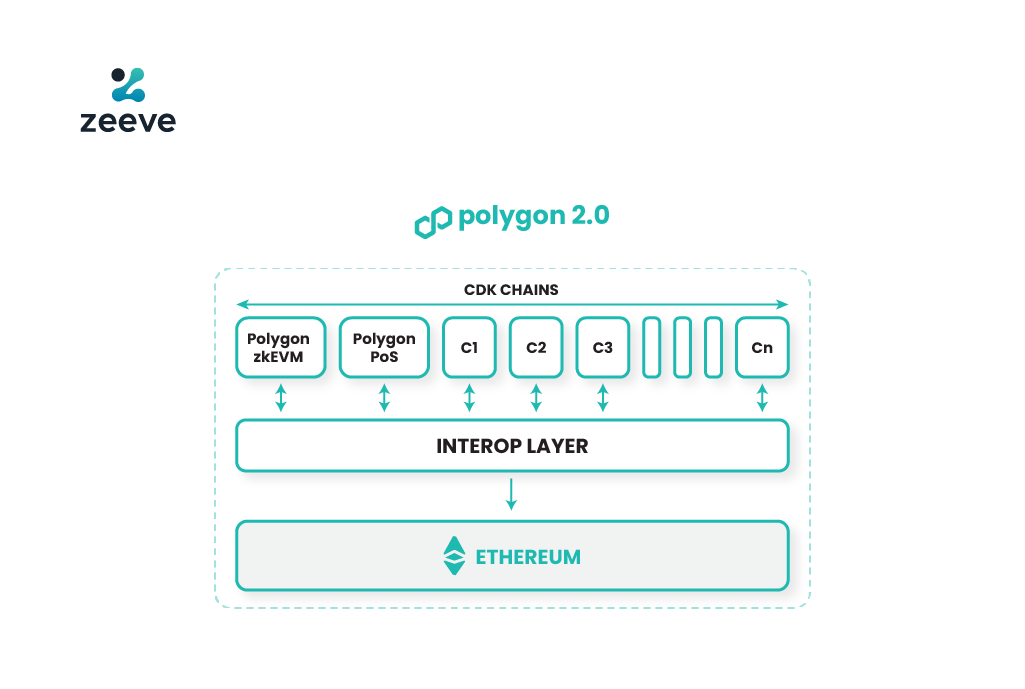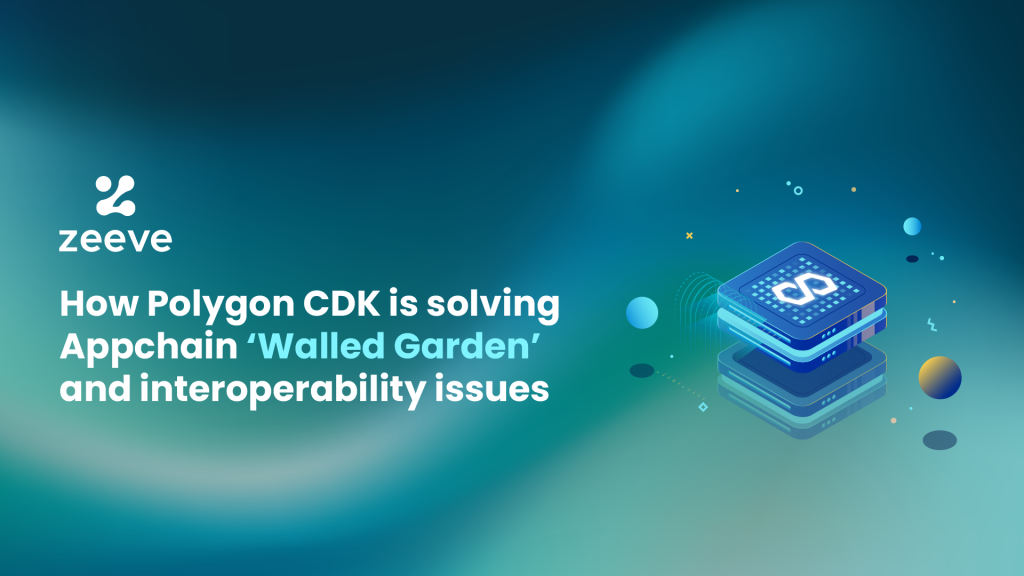While appchains are becoming increasingly popular in the web3 space due to their composability and flexibility benefits, most of the existing appchain ecosystems are associated with challenges such as lack of cross-chain interoperability and ‘walled garden’ issues. Polygon explains this walled garden as the appchain’s struggle to access liquidity from all the leading Polygon chains; be it Polygon PoS, Polygon ZKEvm mainnet, Polygon Supernets, and from Ethereum itself.
Polygon CDK (chain development kit) solves the interoperability friction and the problem of walled garden from the existing Polygon’s supernets ecosystem with novel concepts like shared liquidity and composable interoperability, thus unlocking a whole new Layer 2s experience. Through this article, we will explore the Polygon CDK interoperability and its value proposition in tackling walled garden issues from appchains. Thereby, we will allow businesses to understand why Polygon CDK is getting so much traction and how it claims to be a future-proof appchain ecosystem.
Demystification of Polygon Chain Development Kit (CDK)
Polygon Chain Development Kit (CDK) is a highly modular and customizable open-source framework for rapid development of your own, custom-fitted ZK-powered Layer-2 blockchains. With CDK, web3 projects can choose to build a new Layer-2 chain or seamlessly transition their existing Layer-1 blockchain into Layer-2.
Custom blockchains built with Polygon CDK function as appchains that provide infrastructure to manage a single application instead of focusing on multiple use cases. For example, if you are building a DeFi application that is likely to handle millions of daily active users, then you can build an independent Layer-2 blockchain with Polygon CDK that will fulfill the specific requirements of your project, such as a transaction per second (TPS), custom security parameters, gas fee, and token model.

Polygon CDK is the upgraded version of Supernets, hence CDK made significant improvements in the Supernet’s ecosystem by enabling rapid development of ZK-powered, fully interoperable Layer-2s. Appchains built with CDK serve as high-performing Layer-2 scaling solutions, offering near-infinite scalability. This is possible due to Polygon CDK’s adoption of an evolved version of ZK technology– zkValidium. While Validium works as traditional rollups as it processes transactions off-chain, Validium stands out because it does not store even the transaction data on the main Layer-1 blockchain. Instead, a ZK proof is generated after Data Availability Committees (DACs) verify the transactions. Hence, web3 projects choosing Validium, are required to integrate a secure data availability layer on their appchain. However, there are four key components (layers) of CDK that make up a custom blockchain— Prover, virtual machine, data availability, and sequencer.
To get a broader understanding of CDK’s concepts like Validum, DACs, and more– check out the detailed documentation here.
How Polygon CDK solves ‘Walled Garden’ and interoperability issues of Appchain
Until now, the appchains ecosystem faced challenges like fragmentation of liquidity and friction in achieving end-to-end interoperability. Polygon CDK interoperability eliminates these limitations from the appchain ecosystems through innovative concepts of ‘Unified Liquidity Pool’ and ‘Composable Interoperability’. In practice, this composable interoperability feature also offers benefits like near-instant transaction finality and fluid exchange of assets cross-chain.
As discussed, walled garden refers to the issues of isolated liquidity of blockchain— which mainly occurs due to the lack of interoperability between independent chains. Insufficient liquidity on a blockchain can cause sustainability challenges meanwhile, it impacts the user experience.
Now that CDK is powered by Polygon 2.0’s interoperability layer, every chain built with CDK can seamlessly communicate with all the Polygon chains. For this, independent CDK-based chains have to use a common ZK bridge— LXLY, thereby being able to leverage the shared liquidity from all the adjacent chains. By doing so, CDK eliminates the liquidity issues or ‘walled garden’ issues from appchains.
This native Polygon CDK interoperability enables CDK chains to have automated access to the liquidity of all the Polygon chains. Additionally, they can tap into the entire liquidity of Ethereum with faster, one-click access. This way, the Polygon CDK interoperability eliminates the walled garden issues from its appchain infrastructure, becoming forerunning in the web3 space.
Also read: An Ultimate Guide on Polygon Supernets
Other benefits of building appchain with Polygon CDK
High modularity with customizability and security: With Polygon CDK, web3 projects get a highly modular development environment to build custom ZK-powered Layer-2s, which can serve the very specific use case requirements. The customization can be done for anything– whether it’s about choosing the execution environment, introducing a new token model, gas fee customization, or security aspects. Further, chains deployed on Polygon CDK are protected with cryptographic security, which ensures complete integrity of the transactions without running full nodes. With that, CDK once again removes the complexity of blockchain development.
Hyper scalability with future proof ZK technology: Custom blockchain built with Polygon CDK are powered with Polygon 2.0’s ZK technology, hence it offers a hyper scalable ecosystem. Plus, CDK chains function as an appchain to power a single dApp instead of sharing the ecosystem with a range of applications. Not having competition with other projects means less traffic congestion, fast transaction time, and ultimately a significant boost in the scalability capacity.
Dedicated Data availability layer: Having an independent data availability layer and Data Availability Committee (DAC) allow CDK-based chains to the accessibility and integrity of off-chain data. Which means, DAC is tasked to verify the availability of data for all the blocks of application-specific blockchains. DAC also aids in transferring data storage and computational work off-chain, which reduces the load of Layer-1, thereby enhancing scalability and security.
What are the projects leveraging shared liquidity and interoperability of Polygon CDK
Polygon CDK serves as a future-proof blockchain development framework as it offers battle-tested security, Polygon CDK interoperability, modularity, composability, and a lot of other benefits. Knowing this, a lot of web3 projects are building their custom blockchains from scratch. Whereas, many projects are upgrading their appchain ecosystem from Supernets to CDK. Capx, Aavegotchi, Gnosis pay, and Astar Network are among the first pioneers building with Polygon CDK. Speaking about the recent transition, Canto and Wirex are the projects that have migrated to Polygon CDK to be at the forefront of blockchain technology and the crypto revolution. Let’s understand how these projects are leveraging Polygon CDK:
Canto, a neo finance project, is migrating to custom ZK-powered Layer-2 designed with Polygon CDK framework. The L2 will allow Canto to achieve permissionless sovereignty and shared liquidity of Polygon chains. With this launch, Canto further aims to dive into Ethereum’s liquidity via common ZK bridges without compromising the user’s security. Hence, the combination of sovereignty and interconnection paves the ecosystem for a neo-financial future.
Wirex, the global leader enabling crypto payments, is now using Polygon CDK to build an application-specific blockchain focused on handling just the payments. Wirex’s initial use cases for the CDK chain will be non-custodial visa cards integrated with the Account Abstraction (AA) feature. Wirex adopted CDK due to its ability to access liquidity from all the Polygon Chains plus Ethereum. Also, Wirex mentioned the Polygon CDK interoperability, unbounded scalability, and advanced ZK proofs among their top reasons for building with Polygon CDK. Having such a great response initially, Polygon expects to see a considerable hike in the number of projects either building or migrating to Layer-2s using Polygon CDK.
Zeeve is now a Polygon CDK Implementation partner
Zeeve has become an implementation partner for all the Polygon CDK based chain deployments. Zeeve has optimized its infrastructure-as-a-service offering to match the specific needs of CDK chains, which can be security, Polygon CDK interoperability, or certain accessibility criteria. The DevOps team at Zeeve is versed in using the modules, frameworks, libraries, and other tools required for CDK chain development. Having extensive industry-wide experience, Zeeve understands that launching a blockchain, including CDK chain, is a complex task. Therefore, Zeeve provides ready-to-deploy infrastructure, complete with all the essential components such as wallet, faucet, data indexing tools, testnet faucets, scalable nodes, and more.
Also, Zeeve offers seamless migration assistance, upgrading your existing blockchain to Polygon CDK ecosystem. On top of all these, all your Polygon CDK chains will always remain up and running because Zeeve monitors the network performance on critical parameters where insights are produced on a graphical dashboard. Ultimately, Zeeve cut down the effort and resources of launching a blockchain, thereby, enabling a faster time-to-market of your project. If you are planning to build a custom blockchain with Polygon CDK or you want to migrate existing ecosystem to a CDK-based chain, Zeeve is ready to assist you for this. Connect with our blockchain experts on one-to-one call or join our community discussion for more information about our offerings.























